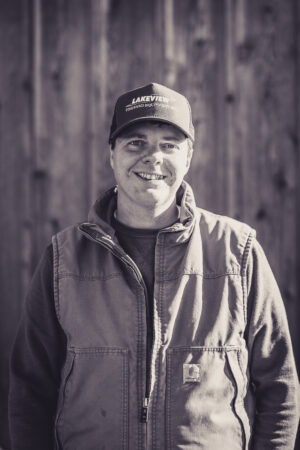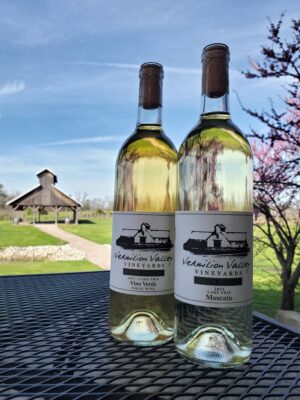One Ohio winery is making low-alcohol wines as a matter of course.
By Paul Vigna
You could say winemaker Joe Juniper at Vermillion Valley Vineyards in Wakeman, Ohio, is ahead of the low-alcohol curve, as the winery annually produces two wines that meet that criteria. But it’s more a matter of circumstance than following a trend or altering what they make, he says.

Juniper, who got into the Ohio wine industry by working in a vineyard as a young teen, became managing partner of the winery — located around 45 miles southwest of Cleveland and 12 miles south of Lake Erie — at age 22. He continues to make the wine there.
Vermillion Valley grows more than 35 winegrape varieties on several vineyards across its 120-acre farm. It’s been making a low-alcohol Moscato (a blend of Moscato Giallo, Orange Muscat, Muscat of Alexandria, Muscat Ottonel and Valvin Muscat) for 12 years and is in the midst of bottling its third vintage of a Vinho Verde, which is a low-alcohol blend of 80% Albariño and 20% Grüner Veltliner.
These wines are being produced at a time when American beverage consumers are becoming more health-conscious, prompting a move toward lower alcohol and lower calorie options.
Naturally low
Some producers use processes such as vacuum distillation and reverse osmosis to achieve their de-alcoholization goals. Juniper says his winery’s lower ABVs are more a product of the vineyard and the cellar than anything requiring machine intervention. The Moscato, for example, is picked early, at 7+ tons per acre and around 16° Brix. This provides some other benefits as well, he said.
It keeps the winery’s carbon footprint a little lower, for example, and it doesn’t have to net or spray as much. “If they tried to do that in the Finger Lakes with some of these varieties — Albariño, for example — it would have searing acidity,” he says. “But for us, we have too little acid generally, so we’re going to the bag of tartaric acid probably as much as many of the regions in the East are going to the bicarbonate.”
The Moscato grapes are blended in a fermentation that utilizes Fermvin SMV yeast and is stopped “when we feel there’s a good balance between sugar and acid,” he says.
It’s a wine that’s generally around 7% ABV, 4.5% residual sugar, 3.1 pH and bottled without carbonation. Vermillion Valley produces around 1,500 cases of it annually; the wine has sold well throughout the years and proven to be shelf stable as much as 2.5 years after bottling.
Juniper says a few years ago, they looked at the whites they sell and noted, to some extent, the similarity between everything from Pinot Grigio and dry Riesling to Sauvignon Blanc and Grüner Veltliner. “We find on our list that there’s a lot of cannibalism between like varieties,” he says. “Aromatic white wines. Obviously, a Grüner Veltliner is different from a Sauvignon Blanc, but they kind of fit the same category.”
 Hence, the development of the Vinho Verde. Vermillion Valley grows almost 10 acres of Albariño, which is harvested at 18°Brix and around 4 tons per acre. It’s whole-cluster pressed and clarified, sterile filtered at bottling and topped with ML solution prior to corking. The result is a wine with an eventual light “spritz” from MLF, 10% ABV, 3.0 pH and no residual sugar.
Hence, the development of the Vinho Verde. Vermillion Valley grows almost 10 acres of Albariño, which is harvested at 18°Brix and around 4 tons per acre. It’s whole-cluster pressed and clarified, sterile filtered at bottling and topped with ML solution prior to corking. The result is a wine with an eventual light “spritz” from MLF, 10% ABV, 3.0 pH and no residual sugar.
“It’s very much distanced itself from the rest of the pack,” Juniper says. “[These wines are] relatively inexpensive, at about $18, and you can drink a bottle or two and not feel the effects of it in the same way.” Vermillion Valley produces around 1,000 cases of Vinho Verde and, with the amount of Albariño it has planted, Juniper is optimistic that it’s a wine they will lean on moving forward. “It gets ripe, it holds acid decently well, but it’s nothing too crazy that we can’t pick early.”
The sweet spot
Three vintages in, Juniper has learned that Vinho Verde is definitely a patio wine that sells predominantly (around 90%) in the summer and one that retains its optimum freshness for only a year or 18 months after bottling.
Juniper serves the wine industry at large as the president of the Ohio Wine Producers Association and is also a board member of National Grape Research Alliance, a member of The Government Affairs Committee for WineAmerica, and on the National Clean Plant Network. His company, Ohio Vineyard Management, owns and operates 120 acres of vineyards on the south shore of Lake Erie.
Juniper said while he’s pleased these wines have found a sweet spot in the Vermillion Valley portfolio, it doesn’t mean more low-alc wines will follow. For one, the regtion’s relatively warm climate limits the grapes they can plant and use for low-alc wine.
Second, he says, there’s the brand reputation to consider and “being yourself” despite where the market is allegedly heading. “In the part of the world I’m in, if I were forced to follow the market I would just grow Concord and Niagara and [that would be it]. Eighty percent of the market in the state of Ohio is Concord and Catawba.
“I say to our accountants, we don’t make the wines that we make for our consumers, we simply just make it to be the best wine it can possibly be. Hopefully there will be someone to buy it. That’s our philosophy.
“Depending on the scale of your operation, sometimes you have to adapt to the market in order to create cash flow. But that hasn’t been our case.”
___________________________________________________________
 Paul Vigna
Paul Vigna
Paul Vigna is a writer and editor in Harrisburg, Pa., who has been covering East Coast wines for 16 years. He was the first winner of the Atlantic Seaboard Wine Association’s Birchenall Award in February 2018. You can find him at the Wine Classroom at www.pennlive.com and follow him on Twitter @pierrecarafe




